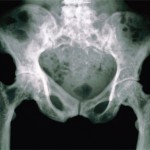Paget’s disease generally affects people over 40, and while the disease is associated with heredity, the cause is unknown. The ACR has recently added a fact sheet about this condition to the patient education material online.
“Normally as people age their bones rebuild at a slower rate,” according to fact sheet author Roy Altman, MD. “For those with Paget’s disease, however, this process of rebuilding bones takes place at a faster rate. As a result, the rebuilt bone has an abnormal structure.” The involved bone can be soft, leading to weakness and bending of the pelvis, back (spine), hips, thighs, head, and arms. The regrowth can also cause the bone to enlarge, making patients more susceptible to arthritis, hearing loss, fractures, and discomfort. Because Paget’s disease occurs in those older than 40, its symptoms are often mistaken for changes associated with aging.
Dr. Altman also notes that, “Paget’s disease does not seriously affect quality of life and, for most people, the outcome is good. In fact, most people with Paget’s disease of bone have no complaints. Rather, it is fast bone rebuilding that leads to complications.”
For more details on diagnosing, treating, and living with Paget’s disease, or to download the fact sheet, visit www.rheumatology.org/public/factsheets.

